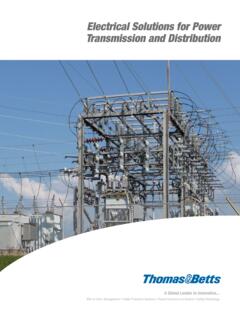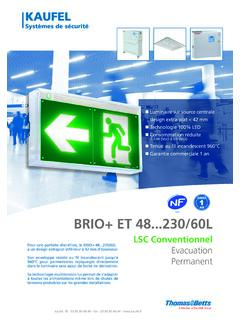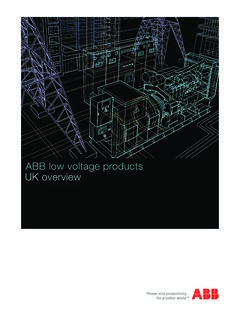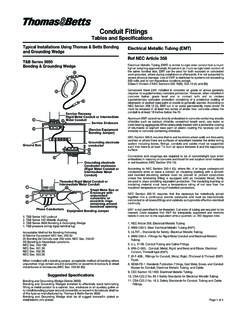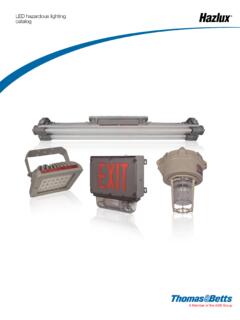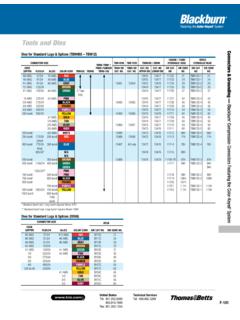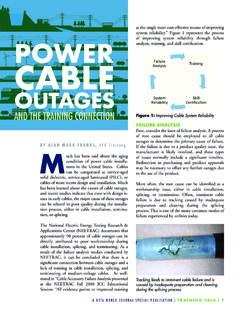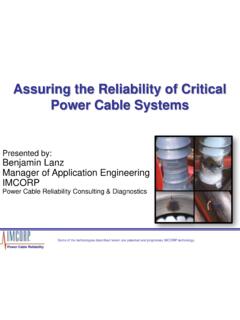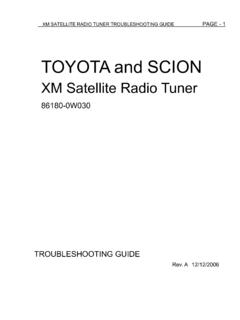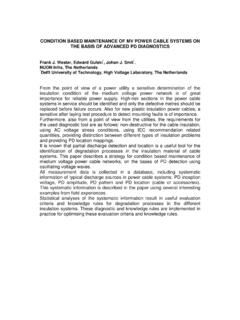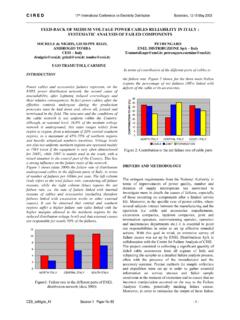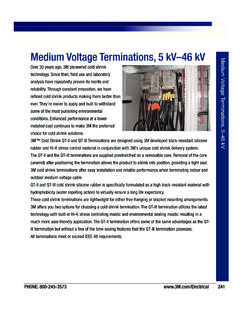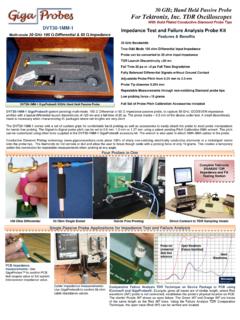Transcription of THOMAS & BETTS CABLE TRAY SYSTEMS - TNB.COM
1 THOMAS & BETTSCABLE of ContentsSECTION 1 - Technical InformationBenefits of CABLE tray ..4 - 5 Features & Benefits ..6 - 7 System of Terms ..9 CABLE tray Selection Process ..10 - 17 Materials and Finishes ..18 - 19 Corrosion ..20 - 21 Types of Resistance Guide ..23 - 29 Electrical Grounding Capacity ..30 Thermal Expansion and Contraction ..31 Structural - 34 Loading ..36 - 37 Loading for Grades B, C and D ..38 Engineering CABLE tray Specification ..40 SECTION 2 - Aluminum CABLE sections ..46 - 59 Fittings ..60 - 99 Accessories and - 112 SECTION 3 - Steel CABLE TrayStraight sections ..116 - 127 Fittings ..128 - 142 Accessories and - 155 SECTION 4 - One Piece CABLE TrayStraight sections.
2 158 - 165 Fittings ..166 - 181 Accessories and - 189 SECTION 5 Common Accessories ..192 - 195 SECTION 6 Grounding ..198 - 200 SECTION 7 Superstrut ..204- 211 SECTION 8 Channel tray ..214 - 239 SECTION - 250 Annex A ..251 Annex - 254 CABLE TraySection 1 Technical Information4 Benefits of CABLE TrayTechnical InformationThe Benefits of CABLE TrayCostCable tray wiring SYSTEMS offer significantadvantages over conduit pipe and other wiringsystems. CABLE tray is less expensive, more reliable,more adaptable to changing needs and easier tomaintain. In addition, its design does not contributeto potential safety problems associated with otherwiring evaluation of the costs and benefits of variouswiring SYSTEMS should be done in the design , many engineers who are unfamiliarwith wiring SYSTEMS avoid the system selectionprocess or defer it until construction oftenresulting in higher costs, scheduling delays and asystem that will not meet future of a wiring system that is not the mostsuitable for a particular application in terms of cost,potential corrosion and electrical considerations canlead to numerous problems, including excessiveinitial cost, poor design, faulty installation, extramaintenance.
3 Future power outages andunnecessary safety experience has shown that the initial cost of a CABLE tray installation (including conductor, material andinstallation labor costs) may be as much as 60% less than a comparable conduit wiring tray SYSTEMS , including trays, supports, fittings and other materials, are generally much less expensive thanconduit wiring SYSTEMS . In addition, major cost savings are generated by the relative ease of installation. Labor costs ofinstalling a CABLE tray system can run up to 50 percent less. Total cost savings will vary with the complexity and size ofthe cost savings are easy to calculate during the design phase of an installation, but the enormous advantages ofcable tray may accrue only over time.
4 The system s reliability, adaptability, ease of maintenance and inherent safetyfeatures result in many other types of cost savings, including: lower engineering and maintenance costs less need to reconfigure system as needs change less down time for electrical and data handling SYSTEMS fewer environmental problems resulting from loss of power to essential tray wiring SYSTEMS lack the inherent safety concerns of conduit it s nature, a conduit wiring system can serve as a flow-through for corrosive, explosive and toxic gases in the sameway that it channels conduit installation process can also present a safety issue for electricians. The process requires that a conduitsystem be installed from one enclosure to another before pulling in the conductors, leaving the electricians exposed toany live, energized equipment that may be in the enclosures.
5 In contrast, installers can pull tray cables from near onetermination enclosure to the next before they are inserted into the enclosures and then , in installations where CABLE tray can be used as the equipment grounding conductor (per NEC standards), it iseasy to visually check the system components as well as conduct checks for electrical of CABLE TrayTechnical InformationReliabilityCable tray SYSTEMS offer unsurpassed reliability, resulting in less need for maintenance and less down time importantconsiderations for all installations but especially for such industries as data communications and financial addition, since CABLE tray is not a closed system, moisture build up problems are eliminated and damage to cableinsulation during installation is also greatly major advantage of CABLE tray SYSTEMS derives from their adaptability to new needs and technology.
6 The pace ofchange in the economy, constantly shifting competitive pressures and rapid introduction of innovative technologiesare all accelerating. More than ever before, businesses must be prepared to quickly expand facilities, changeproducts or introduce new processes. The flexibility of the wiring system is a key a CABLE tray system or adding cables to meet new needs is relatively easy because cables can enter or exita tray at any point. And initial design considerations can build-in extra capacity as part of the planning process. Cabletray s inherent adaptability allows rewiring for future expansion, building redesign or new technologies withoutdisruption or need to replace the entire wiring tray wiring SYSTEMS require less maintenance than conduit SYSTEMS .
7 When maintenance is necessary, it iseasier, less time-consuming and less labor physical condition and status of both the CABLE tray and the tray cables can be inspected visually, something thatis not possible with conduit SYSTEMS . In addition, it is also easy to see if there is sufficient capacity in the trays foradditional cables. As was noted above, changing or adding cables can also be accomplished without comparative benefit of CABLE tray SYSTEMS is that they do not act as channels of moisture paths, as conduitwiring SYSTEMS do. Conduit SYSTEMS tend to collect condensation resulting from changes in temperature and thenchannel the moisture to electrical equipment, where it can lead to corrosion and failure .
8 CABLE tray and tray CABLE are also less susceptible to fire loss than conduit. An external fire usually results in damageto only a few feet of a CABLE tray system, while wire insulation inside a conduit suffers significant damage andthermoplastic insulation may actually fuse to the & Benefits Technical InformationAluminum Maximum structural THOMAS & BETTS Unique Design Points Snap-in aluminum splice plates for easy Splice Plates Alternating rungs for top and bottom accessory installation and CABLE Rungs Rungs have continuous open slot to accept standard strut pipe clamps and gives complete barrier strip SiderailAluminumAluminum &SteelAluminum &SteelContinuous Open Slot7 Features & BenefitsTechnical InformationAluminum &Steel Exclusive Ty-Rap CABLE tie slots on 1 centerson all ladder and ventilated cables without kinks and
9 Keeps cables THOMAS & BETTS Unique Design Points Aluminum and Steel Solid bottoms are constructed with a flat sheet for added CABLE Support Extra wide rung design for maximum CABLE bearing Wide Rung Design Barrier strips are fully adjustable (side to side) for use in straight sections and CABLE Tie SlotsAluminum &SteelAluminum &SteelAluminum & m / 72 3 m / 144 Adjustable Barrier StripsTechnicalInformationSystem Design8 Technical InformationSample Plant LayoutABCDEFGHIJKLMNOPQRABCDEFGHIJKLNMNC OMMERCIALINDUSTRIALS choolsPetro-Chemical PlantsHospitalsAutomotive PlantsOffice BuildingsPaper PlantsAirportsFood ProcessingCasinosPower PlantsStadiumsRefineriesManufacturingMin ingOPQAB arrier StripBBox ConnectorCFlat CoverDHorizontal CrossEHorizontal 45 FHorizontal 90 GHorizontal TeeHLadder TrayIPeaked CoverJRight ReducerKSolid TrayLSplice ConnectorMSolid Channel TrayNVentilated TrayOVertical 90 InsidePVertical 90 OutsideQVertical
10 TeeApplication9 Technical InformationGlossary of TermsAccessories.. Devices which are used to supplement the function of straight sections and fittings, andinclude such items as dropouts, covers, conduit adapters, hold-down devices TrayConnector.. A device which joins CABLE tray straight sections or fittings, or both. The basic types of connectors are: , , , tray Fitting.. A device which is used to change the direction, elevation or size of a CABLE tray Support.. A device which provides adequate means for supporting CABLE tray sections or fittings,or both. The basic types of CABLE tray supports are: bracket, , and suspensionChannel CABLE tray .. A prefabricated metal structure consisting of a one-piece ventilated bottom or solidbottom channel section, or both, not exceeding 6 inches in CABLE tray .


